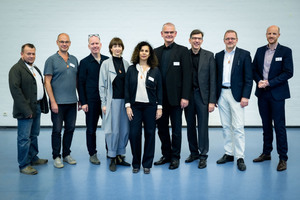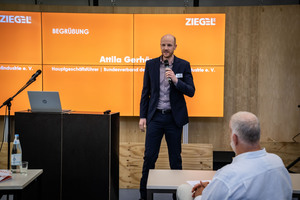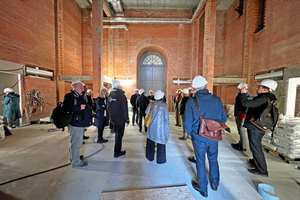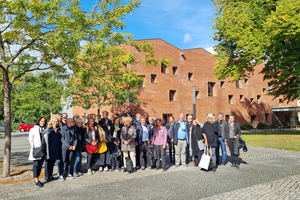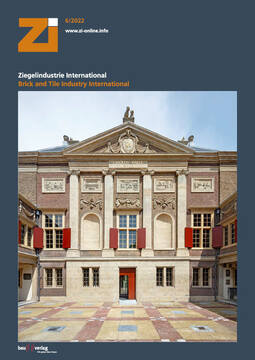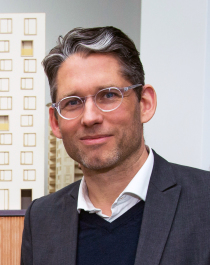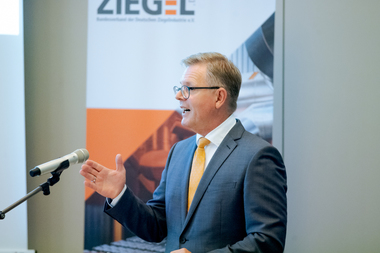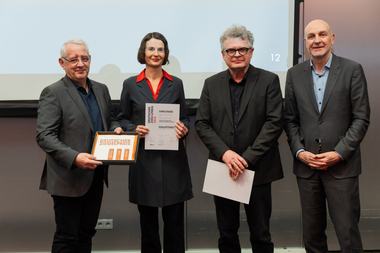“Brick is always worth a trip” - Professor Practice Days 2022 in Berlin
From September 16 to 18, 2022, the Professor Practice Days took place in Berlin, organized by the university team of the Federal Association of the German Brick and Tile Industry (BVZi). 45 teachers from universities and colleges in Germany participated in the conference on Friday and the two excursions on the following weekend.
The event ties in with the annual professor conferences and excursions hosted by the former Brick Center South from 2006 to 2019. Due to Corona, these had been cancelled in the past two years. There had also been organizational changes. The Brick Center South has been integrated into the BVZi. In the course of this, the university work, which was previously limited to the five southern German states, has been set up nationwide.
Conference
The conference was held in the Forum of the Institute of Architecture at the Technical University of Berlin. The program included a total of six lectures divided into two panels. The third lecture on “Future recycling options of demolition bricks for soil and roof substrates” by Sebastian Knoll was unfortunately due to sickness cancelled. Jan Krause from the office for architectural thinking in Berlin led through the program and discussions as moderator.
Attila Gerhäuser, general manager of BVZi, welcomed the participants. In his opening speech he outlined the brick industry and the tense situation caused by the gas and energy crisis. He thanked the architects Annette Drosdeck and Anita Benja for hosting and organizing the practice days.
Ralf Pasel, Professor of Architecture at the TU in the Department of Structural Engineering and host of the conference, used his welcoming address to praise the brick. In a case study on brick construction with a women’s cooperative in Bolivia, he said, the building material had proven to be low-threshold in its application and, when arranged in the appropriate bond, earthquake-resistant. Together with the very good thermal properties, bricks have great potential as a building material of the future.
Presentations of the first panel
In the first lecture, Tobias Nöfer, architect and urban planner in Berlin, referred to the exhibition “Unfinished Metropolis: Urban Planning for Greater Berlin”, which is dedicated to urban planning history, present and future. In his lecture, Nöfer focused on diachronic urban planning references that continue to shape the form of the “unfinished metropolis” to this day. He explained how the shape of Berlin can be traced back to the settlement star, why Berlin was once called the city of 54 city halls, and reported on prevented highway planning in Kreuzberg, deep in Berlin’s inner city. At the same time, he shed light on the urban development potential of the Berlin-Brandenburg urban region and its future prospects.
The architect Frank Arnold, Arnold und Gladisch Objektplanung Generalplanung GmbH Berlin, discussed in his lecture how “low-cost housing construction with bricks” is possible. Using the example of four sustainable, high-quality residential buildings he had developed himself, he described successful implementations and what could be transferred to future housing projects. An important cost-reducing factor was the use of thermally insulated vertically perforated bricks. In his experience, working with a general contractor can significantly increase cost and time efficiency in residential construction without compromising architectural quality.
Presentations of the second panel
After a coffee break, the second panel began with the presentation “Rethinking Brick: From pre-industrial methods to baked-in situ earth houses.” Prof. Dr. Anupama Kundoo, Anupama Kundoo architects in Berlin, presented the potential of brick for sustainable and cost-effective building methods. She told of how, in India, bricks formed from rain-wet clay and stacked to form the kiln whose heat is used to fire them. About 40 percent of kiln firing energy goes into the kiln, not the product. This is avoided here. This method is significantly more time-consuming than conventional industrial production. But it provides affordable building materials for people in India and comparable countries with minimal environmental impact.
Prof. Dr. Linda Hildebrand, architect from RWTH Aachen University, spoke in her lecture “Building products in a cycle - circularity in architecture” about the possibilities of a construction method based on cycles of values, information and resources. In contrast to life cycle analysis, such a systemic approach consistently focuses on the question of subsequent use. The first condition of this approach is to assign the materials bound in the building to further utilization cycles for subsequent use as early as the building planning stage. The second condition is a circular economic model that enables such cycles. Secondary material use, he said, is the key to the building turnaround.
In the last lecture of the day, architect Stefan Goeddertz, associate at Herzog & de Meuron Basel, and Prof. Dr. Toralf Burkert, Jäger Ingenieure GmbH in Radebeul, reported on experiences with “Masonry in Context”. Using the example of the Elbe Philharmonic Hall in Hamburg, they described the challenges posed by the plan to place a large, technically and creatively sophisticated building on top of an old warehouse building. The transformation to a brick base touched on aspects of historic preservation, statics and cost, as well as climatic issues such as moisture protection. This included permanent, electronic remote monitoring of the building’s hydrophobicity.
Excursion through Potsdam and Berlin
The two-day excursion program took the participants on Saturday, September 17, in a wide arc from Potsdam through southern and eastern to northern Berlin. In Potsdam, three projects currently under construction were visited: the reconstruction of the Potsdam Garrison Church with its 60-meter-high masonry tower, the construction of the New Synagogue, whose sand-colored brick facade makes reference both to the Brandenburg brick construction method and to the tradition of building sacred buildings with brick, and the reconstruction of apartment buildings on the Old Market Square. Guided tours by project managers and architects such as Jost Haberland and Prof. Donatella Fioretti complemented the visits.
After lunch at the Genusswerkstatt Potsdam, the excursion visitedt Bruno Taut’s Hufeisensiedlung in Berlin-Neukölln and the Mittelpunktbibliothek in Berlin-Köpenick planned by Bruno Fioretti Marquez Architekten. The tour continued with visits to the Kastanienhof Berlin-Kaulsdorf, a farm building converted for residential purposes, the construction site Wohnquartier Kastanienallee in Berlin-Hellersdorf and to the Stacked House in Berlin-Weißensee. A nice opportunity to end the first day of the excursion was the canteen of David Chipperfield Architects.
The Sunday program focused on the city center of Berlin. Under the guidance of Thomas M. Krüger of TICKET B - Architektur erleben, the New National Gallery, the townhouses on Friedrichswerder, the residential and commercial building on Schinkelplatz, Friedrichwerdersche Kirche and Haus Bastian on Museuminsel, as well as the new James Simon Gallery were visited. The main focus of the day was the guided tour of the construction site Am Tacheles. There, a mixed-use urban quarter with apartments, retail and offices is being built on 85,000 square meters, interspersed with landscaped public squares and a public thoroughfare from Oranienburger Strasse to Friedrichstrasse. The official conclusion of the Professor Practice Days was the joint lunch at the Gendarmenmarkt.
Afterwards, the organizers drew a very positive conclusion. They particularly emphasized the fruitful discussions and the atmosphere of shared exchange. Feedback letters from the participants were also full of praise, according to the organizers. The statement of one participant seems to have proved true: “Brick is always worth a trip.”

